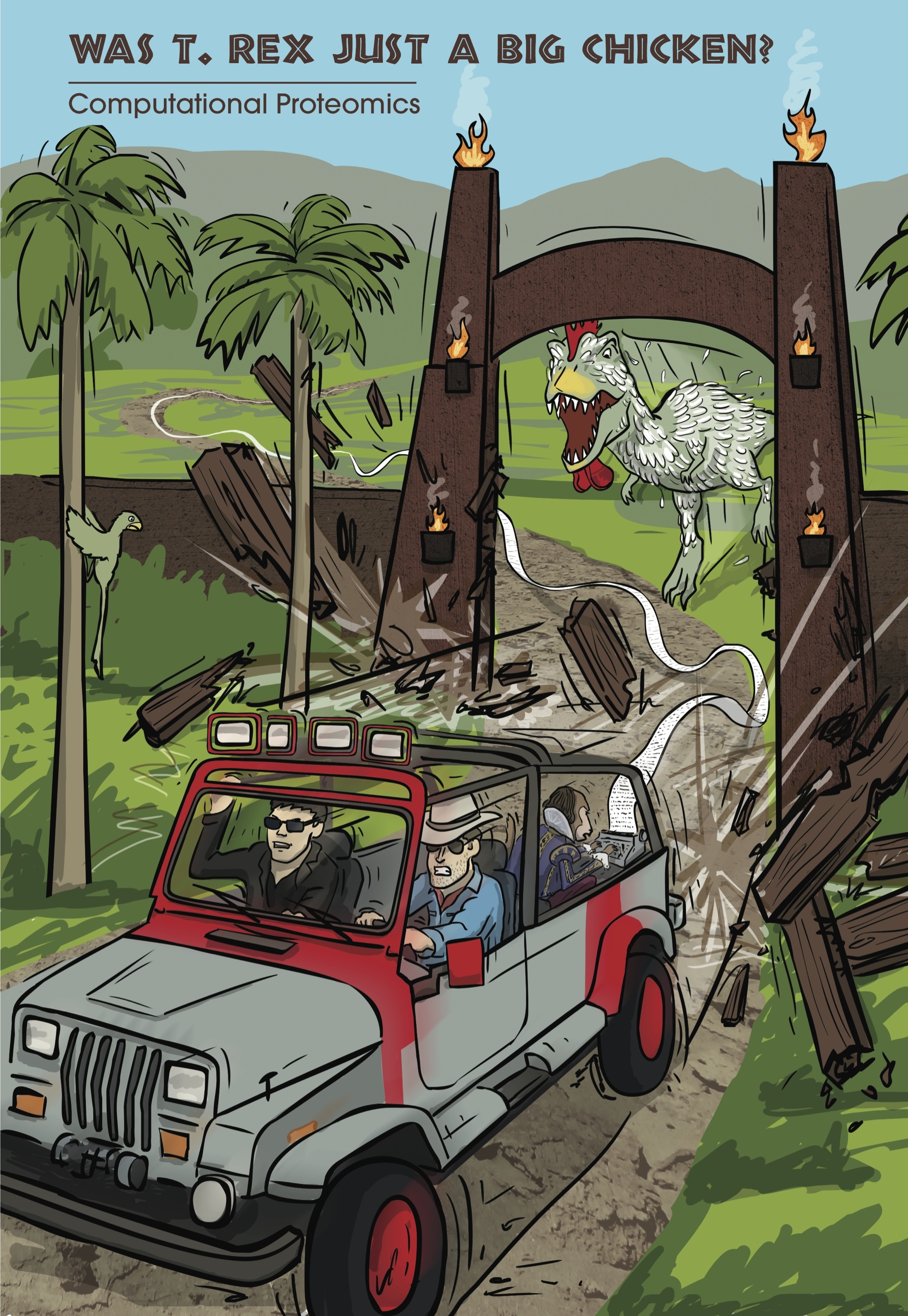
In the previous course in the Specialization, we learned how to compare genes, proteins, and genomes. One way we can use these methods is in order to construct a "Tree of Life" showing how a large collection of related organisms have evolved over time.
In the first half of the course, we will discuss approaches for evolutionary tree construction that have been the subject of some of the most cited scientific papers of all time, and show how they can resolve quandaries from finding the origin of a deadly virus to locating the birthplace of modern humans.
Read more
In the previous course in the Specialization, we learned how to compare genes, proteins, and genomes. One way we can use these methods is in order to construct a "Tree of Life" showing how a large collection of related organisms have evolved over time.
In the first half of the course, we will discuss approaches for evolutionary tree construction that have been the subject of some of the most cited scientific papers of all time, and show how they can resolve quandaries from finding the origin of a deadly virus to locating the birthplace of modern humans.
In the previous course in the Specialization, we learned how to compare genes, proteins, and genomes. One way we can use these methods is in order to construct a "Tree of Life" showing how a large collection of related organisms have evolved over time.
In the first half of the course, we will discuss approaches for evolutionary tree construction that have been the subject of some of the most cited scientific papers of all time, and show how they can resolve quandaries from finding the origin of a deadly virus to locating the birthplace of modern humans.
In the second half of the course, we will shift gears and examine the old claim that birds evolved from dinosaurs. How can we prove this? In particular, we will examine a result that claimed that peptides harvested from a T. rex fossil closely matched peptides found in chickens. In particular, we will use methods from computational proteomics to ask how we could assess whether this result is valid or due to some form of contamination.
Finally, you will learn how to apply popular bioinformatics software tools to reconstruct an evolutionary tree of ebolaviruses and identify the source of the recent Ebola epidemic that caused global headlines.
What's inside
Syllabus
Week 1: Introduction to Evolutionary Tree Construction
Welcome to our class!
In this class, we will consider the following two central biological questions (the computational approaches needed to solve them are shown in parentheses):
- Weeks 1-3: Which Animal Gave Us SARS? (Evolutionary tree construction)
- Weeks 4-5: Was T. rex Just a Big Chicken? (Combinatorial Algorithms)
In Week 6, you will complete a Bioinformatics Application Challenge to apply evolutionary tree construction algorithms in order to determine the origin of the recent ebola outbreak in Africa.
As in previous courses, each of these two chapters is accompanied by a Bioinformatics Cartoon created by talented artist Randall Christopher and serving as a chapter header in the Specialization's bestselling print companion. You can find the first chapter's cartoon at the bottom of this message. What do stick bugs and bats have to do with deadly viruses? And how can bioinformatics be used to stop these viruses in their tracks? Start learning today and find out!

Read more
Syllabus
Welcome to our class!
In this class, we will consider the following two central biological questions (the computational approaches needed to solve them are shown in parentheses):
- Weeks 1-3: Which Animal Gave Us SARS? (Evolutionary tree construction)
- Weeks 4-5: Was T. rex Just a Big Chicken? (Combinatorial Algorithms)
In Week 6, you will complete a Bioinformatics Application Challenge to apply evolutionary tree construction algorithms in order to determine the origin of the recent ebola outbreak in Africa.
As in previous courses, each of these two chapters is accompanied by a Bioinformatics Cartoon created by talented artist Randall Christopher and serving as a chapter header in the Specialization's bestselling print companion. You can find the first chapter's cartoon at the bottom of this message. What do stick bugs and bats have to do with deadly viruses? And how can bioinformatics be used to stop these viruses in their tracks? Start learning today and find out!

Welcome to Week 2 of class!
Last week, we started to see how evolutionary trees can be constructed from distance matrices. This week, we will encounter additional algorithms for this purpose, including the neighbor-joining algorithm, which has become one of the top-ten most cited papers in all of science since its introduction three decades ago.
Welcome to week 3 of class!
Over the last two weeks, we have seen several different algorithms for constructing evolutionary trees from distance matrices.
This week, we will conclude the current chapter by considering what happens if we use properties called "characters" instead of distances. We will also see how to infer the ancestral states of organisms in an evolutionary tree, and consider whether it is possible to define an efficient algorithm for this task.
Welcome to week 4 of the class!
Did birds evolve from dinosaurs? Over the next two weeks, we will see how we could analyze molecular evidence in support of this theory. You can find this week's Bioinformatics Cartoon from Randall Christopher at the bottom of this E-mail. Why does the T. rex look so much like a chicken? And why is the monkey typing frantically? Keep learning to find out!

Welcome to week 5 of class!
Last week, we asked whether it is possible for dinosaur peptides to survive locked inside of a fossil for 65 million years. This week, we will see what this question has to do with statistics; in the process, we will see how a monkey typing out symbols on a typewriter can be used to address it.
Welcome to the sixth and final week of the course!
In this week's Bioinformatics Application Challenge, we will use reconstruct an evolutionary tree of ebolaviruses and use it to determine the origin of the pathogen that caused the recent outbreak in Africa.
Good to know
Save this course
Reviews summary
Challenging bioinformatics elective
Activities
Review Basic Biology
Show steps
Reviewing basic biology will help you understand the concepts of evolutionary tree construction.
Show steps
-
Read a textbook.
-
Watch videos.
-
Take a practice quiz.
-
Attend a review session.
Follow Tutorials on Evolutionary Tree Construction
Show steps
Following tutorials will introduce you to the basic concepts of evolutionary tree construction.
Show steps
-
Find a set of tutorials.
-
Follow the tutorials.
-
Complete the exercises.
Read "Introduction to Bioinformatics Algorithms"
Show steps
This book provides a comprehensive overview of the algorithms and techniques used in bioinformatics, including evolutionary tree construction.
View
BIOINFORMATICS ALGORITHMS
on Amazon
Show steps
-
Read the chapters on evolutionary tree construction.
-
Work through the exercises in the book.
-
Apply the algorithms to real-world data.
Six other activities
Expand to see all activities and additional details
Show all nine activities
Participate in Peer Study Groups
Show steps
Participating in peer study groups will allow you to discuss the course material with other students and get help from your peers.
Show steps
-
Find a study group.
-
Attend the study group meetings.
-
Participate in the discussions.
-
Help your peers.
Build an Evolutionary Tree from Scratch
Show steps
Constructing an evolutionary tree from scratch will reinforce your understanding of the algorithms and techniques discussed in the course.
Show steps
-
Gather data on a set of organisms.
-
Calculate the distance matrix between the organisms.
-
Choose an appropriate tree-building algorithm.
-
Construct the tree.
-
Evaluate the tree.
Practice Evolutionary Tree Construction Problems
Show steps
Practicing problem-solving will improve your skills in constructing evolutionary trees.
Show steps
-
Find a set of practice problems.
-
Solve the problems.
-
Review your solutions.
Create a Tutorial on Evolutionary Tree Construction
Show steps
Creating a tutorial will help you solidify your understanding of evolutionary tree construction and share your knowledge with others.
Show steps
-
Choose a topic.
-
Research the topic.
-
Write the tutorial.
-
Publish the tutorial.
Attend a Workshop on Evolutionary Tree Construction
Show steps
Attending a workshop will provide you with an opportunity to learn from experts in the field and network with other professionals.
Show steps
-
Find a workshop.
-
Register for the workshop.
-
Attend the workshop.
-
Participate in the discussions.
-
Network with other attendees.
Volunteer at a Research Lab
Show steps
Volunteering at a research lab will give you hands-on experience with evolutionary tree construction and other bioinformatics techniques.
Show steps
-
Find a research lab.
-
Contact the lab director.
-
Volunteer your time.
-
Work on a project.
Review Basic Biology
Show steps
Reviewing basic biology will help you understand the concepts of evolutionary tree construction.
Show steps
- Read a textbook.
- Watch videos.
- Take a practice quiz.
- Attend a review session.
Follow Tutorials on Evolutionary Tree Construction
Show steps
Following tutorials will introduce you to the basic concepts of evolutionary tree construction.
Show steps
- Find a set of tutorials.
- Follow the tutorials.
- Complete the exercises.
Read "Introduction to Bioinformatics Algorithms"
Show steps
This book provides a comprehensive overview of the algorithms and techniques used in bioinformatics, including evolutionary tree construction.
View
BIOINFORMATICS ALGORITHMS
on Amazon
Show steps
- Read the chapters on evolutionary tree construction.
- Work through the exercises in the book.
- Apply the algorithms to real-world data.
Participate in Peer Study Groups
Show steps
Participating in peer study groups will allow you to discuss the course material with other students and get help from your peers.
Show steps
- Find a study group.
- Attend the study group meetings.
- Participate in the discussions.
- Help your peers.
Build an Evolutionary Tree from Scratch
Show steps
Constructing an evolutionary tree from scratch will reinforce your understanding of the algorithms and techniques discussed in the course.
Show steps
- Gather data on a set of organisms.
- Calculate the distance matrix between the organisms.
- Choose an appropriate tree-building algorithm.
- Construct the tree.
- Evaluate the tree.
Practice Evolutionary Tree Construction Problems
Show steps
Practicing problem-solving will improve your skills in constructing evolutionary trees.
Show steps
- Find a set of practice problems.
- Solve the problems.
- Review your solutions.
Create a Tutorial on Evolutionary Tree Construction
Show steps
Creating a tutorial will help you solidify your understanding of evolutionary tree construction and share your knowledge with others.
Show steps
- Choose a topic.
- Research the topic.
- Write the tutorial.
- Publish the tutorial.
Attend a Workshop on Evolutionary Tree Construction
Show steps
Attending a workshop will provide you with an opportunity to learn from experts in the field and network with other professionals.
Show steps
- Find a workshop.
- Register for the workshop.
- Attend the workshop.
- Participate in the discussions.
- Network with other attendees.
Volunteer at a Research Lab
Show steps
Volunteering at a research lab will give you hands-on experience with evolutionary tree construction and other bioinformatics techniques.
Show steps
- Find a research lab.
- Contact the lab director.
- Volunteer your time.
- Work on a project.
Career center
Computational Biologist
Bioinformatics Scientist
Data Scientist
Statistician
Software Engineer
Biomedical Engineer
Genetic Counselor
Research Scientist
Reading list
Share
Similar courses
OpenCourser helps millions of learners each year. People visit us to learn workspace skills, ace their exams, and nurture their curiosity.
Our extensive catalog contains over 50,000 courses and twice as many books. Browse by search, by topic, or even by career interests. We'll match you to the right resources quickly.
Find this site helpful? Tell a friend about us.
We're supported by our community of learners. When you purchase or subscribe to courses and programs or purchase books, we may earn a commission from our partners.
Your purchases help us maintain our catalog and keep our servers humming without ads.
Thank you for supporting OpenCourser.



